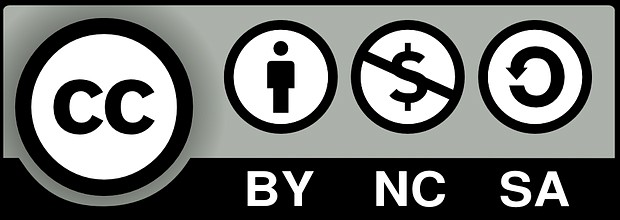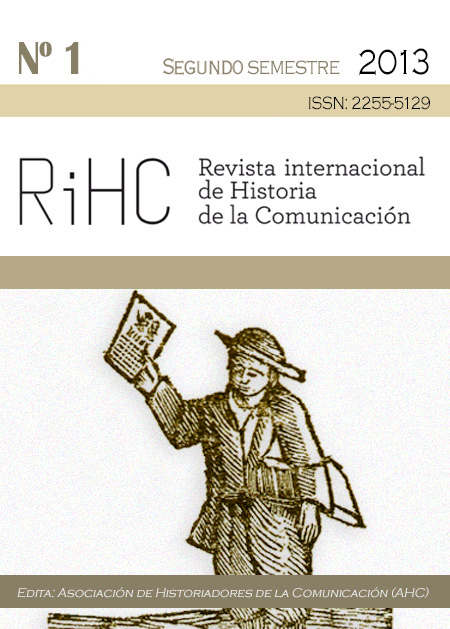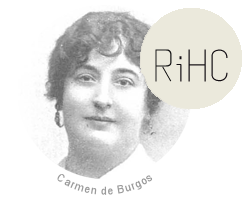A history of journalism on the internet: A state of the art and some methodological trends
DOI:
https://doi.org/10.12795/RiHC.2013.i01.12Palabras clave:
Historiografía, Internet, World Wide Web, Historia, PeriodismoResumen
La historiografía de los nuevos medios ha ido adquiriendo, sobre todo en la última década, una considerable importancia, especialmente aquella dedicada a la investigación histórica sobre la World Wide Web (vide Brügger, 2010). Peviamente, la historia de los medios de comunicación se había beneficiado de la perspectiva de la historia social y cultural, representada, entre otros, por Burke o Briggs. Desde esos puntos de vista, intentamos en este artículo explicar la historia de las primeras décadas de periodismo en internet, y poner de manifiesto algunos retos metodológicos relacionados con la investigación histórica sobre el tema.
Descargas
Citas
ALTERMAN, ERIC (2008). Out of Print. The Death and Life of the American Newspaper. The New Yorker, March 31. <http://www.newyorker.comreporting/2008/03/31/080331fa-fact_alterman>. Accessed: October 20, 2011.
ANDREWS, R. (2007). Search engines drive more readers to news sites. Journalism.co.uk: <http://www.journalism.co.uk/2/articles/53294.php>. Accessed: December 1st, 2009
BARBOSA, SUZANA; MEIRELES, SUZANA (2009). Microjornalismo como modalidade emergente da Web 2.0. In: I Congreso Internacional de Ciberperiodismo y Web 2.0. Bilbao, November 11th, 12th and 13th. Bilbao: University of the Basque Country.
BASTOS, HELDER (2010). Origens e evoluçao do ciberjornalismo em Portugal. Os primeiros quinze anos (1995-2010). Porto: Afrontamento.
BOCZKOWSKI P.J.; DE SANTOS, M. (2007). When more media equals less news: Patterns of content homogenization in Argentina's leading print and Online newspapers. Political Communication, 24(2): 167-180.
BOCZKOWSKI, P. J.; FERRIS, J.A. (2005). Multiple Media, Convergent Processes, and Divergent Products: Organizational Innovation in Digital Media Production at a European Firm, The Annals of the American Academy of Political and Social Science, 597: 32–47.
BOCZKOWSKI, PABLO (2004a) The processes of adopting multimedia and interactivity in three online newsrooms, Journal of Communication, 54: 197–213. – (2004b) Digitizing the News: Innovation in Online Newspapers (Inside Technology). Cambridge: The MIT Press.
– (2004c). The development and use of online newspapers. What research tells us and what we might want to know. Lievrouw, L.; S. Livingstone (eds.). Handbook of new media. London: Sage, 2004: 270-286.
– (2009). Materiality and Mimicry in Journalism Field. In B. Zelizer (ed.): The Changing Faces of Journalism: Tabloidization, Technology, and Truthiness. London; New York: Routledge: 56–67.
BRIGGS, ASA; BURKE, PETER (2002). A Social History of the Media. Cambridge: Polity.
BRÜGGER, N. (ed.) (2010). Web History. New York, etc.: Peter Lang: 213-232.
BURKE, PETER (1992). History and social theory. Cambridge: Polity Press.
CARVAJAL, M.; GARCÍA AVILÉS, J. A.; GONZÁLEZ ESTEBAN, J. L. (2011). The News Production Process about the U.S. Embassy Cables: How The Guardian, The New York Times and El País Covered and Released the Documents Provided by Wikileaks. Salaverría, Ramón (ed.). Diversity of Journalisms. Conference Proceedings (CICOM+ECREA). Pamplona: Servicio de Publicaciones de la Universidad de Navarra: 83-91.
CAVALLO, GUGLIELMO; CHARTIER, ROGER (dir.) (1998). Historia de la lectura en el mundo occidental. Madrid: Taurus.
COHEN, DANIEL; ROZENZWEIG, ROY (2005). Digital History: A Guide to Gathering, Preserving, and Presenting the Past on the Web. Philadelphia: University of Pennsylvania Press <http://chnm.gmu.edu/digitalhistory/>. Accessed: November 24, 2011.
DARNTON, R. (1999). The New Age of the Book. The New York Review of Books, March 18 <http://www.nybooks.com/articles/archives/1999/mar/18/the-new-age-ofthe-book/?pagination=false>. Accessed: November 15, 2011.
DEEGAN, MARILYN; STEINVEL, EMIL; KING, EDMUND (2002). Digitizing historic newspapers: progress and projects. RLG DigiNews, 6 (4) <http://www.rlg.org/preserv/diginews/index.html>.
DEUZE, M. (2008). Understanding Journalism as Newswork: How It Changes, and How It remains the Same. Westminsters Papers In Communication and Culture. London: University of Westminster.
DÍAZ NOCI, JAVIER (1999a). Digital publishing: Electronic books, journals and newspapers on the Internet. Workshop on Digital Publishing and Education, Department for Continuing Education, University of Oxford, 14th May, 1999. <http://www.ehu.es/diaz-noci/Conf/C18.pdf>.
DILLER, H. J. (2000). Kenneth Starr and Us. The Internet and the Vanishing of the Journalist. Ungerer, F. (ed.). English Media Texts Past and Present. Language and Textual Structure. Amsterdam; Philadelphia: John Benjamins Publishing Company: 197-213.
EISENSTEIN, E. (1979). The printing press as an agent of change: communications and cultural transformations in early modern Europe (2 vols. ed.). Cambridge UK: Cambridge University Press.
ELMER-DEWITT, P. (1995). Welcome to Cyberspace. Time, 145(12): <http://www.well.com/~ped/clips/Cyberspace_Cover_Spring.95>. Accessed: November 24, 2011.
FOGEL, JEAN-FRANÇOIS; PATIÑO, BRUNO (2005). Une Presse sans Gutenberg. Paris: Grasset & Frasquelle.
GRACIA CÁRCAMO, JUAN (2005). Medios y formas de comunicación en el Bilbao contemporáneo (siglos XIX-XX). Reflexiones desde la historia sociocultural. Medios y empresas de comunicación. Bidebarrieta. Revista de Humanidades y Ciencias Sociales de Bilbao. Bilbao: Ayuntamiento de Bilbao, 29-86.
GREER, J.; MENSING, D. (2003). The evolution of Online Newspapers: A longitudinal content analysis, 1997-2003, Newspaper division of the Association for Education in Journalism and Mass Communication for the 2003 annual conference.
– (2006). Early Trends in Online Newspaper Content. Li, Xigen (ed.) (2006). Internet Newspapers: The Making of a Mainstream Medium. Mahwah, NJ: Lawrence Erlbaum: 13-32.
GUALLAR, JAVIER; ABADAL, ERNEST (2010). The digital press archives of the leading Spanish online newspapers. Information Research, 15(1): <http://informationr.net/ir/15-1/paper424.html>. Accessed: November 24, 2011.
HERSCOVITZ, HELOIZA G. (2009). Brazilian News Portal Characteristics. Brazilian Journalism Research 5(1): 99-122.
HIGGS, EDWARD (ed.) (1998). History and electronic artefacts. Oxford: Clarendon Press.
HUNT, LYNN (ed.) (1989). The new cultural history. Berkeley etc.: University of California Press.
KEEFER, A.; GALLART, N. (2007). La preservación de recursos digitales: el reto para las bibliotecas del siglo XXI. Barcelona: UOC.
MCLUHAN, MARSHALL (1994). Understanding Media. The Extensions of Man. Cambridge, MA; London: The MIT Press.
MEYER, P. (2009). The Elite Newspaper of the Future. American Journalism Review, October/November <http://www.ajr.org/Article.asp?id=4605>. Accessed: December 3, 2009.
– (2010). La supervivencia en la Web 3.0. Infoamérica. Iberoamerican Communication Review, Cátedra Unesco de la Universidad de Málaga, 2: 39-57.
PAVLIK, JOHN (2001). Journalism and new media. New York: Columbia University Press.
– (2004). A Sea-Change in Journalism: Convergence, Journalists, their Audiences and Sources. Convergence, 10: 21 – 29.
PRENSKY, M. (2001). Digital Natives, Digital Immigrants. On the Horizon, 9 (5). <http://www.marcprensky.com/writing/Prensky%20-%20Digital%20Natives,%Digital%20Immigrants%20-%20Part1.pdf>. Accessed: October 15, 2011.
SALWEN, M.B.; GARRISON, B.; DRISCOLL, (eds.). Online news and the public. Mahwah, NJ: Lawrence Erlbaum.
SMARTT, M. (2007). The days before launch. BBC Internet Blog <http://www.bbc.co.uk/blogs/bbcinternet/2007/12/the_days_before_launch.html>. Accessed: November 24, 2011.
SMITH, ANTHONY (1980). Goodbye Gutenberg. The Newspaper Revolution of the 1980's, Oxford-New York: Oxford University Press.
– (2010). El periódico que viene. Reconstrucción del escenario mediático. Infoamérica. Iberoamerican Communication Review, Cátedra Unesco de la Universidad de Málaga, 2: 7-19.
STARR, P. (2009). Goodbye to the Age of Newspapers (Hello to a New Era of Corruption). Why American politics and society are about to be changed for the worse. The New Republic < http://www.tnr.com/article/goodbye-the-agenewspapers-hello-new-era-corruption?page=1>. Accessed: December 3, 2009.
THORSEN, E. (2008). Journalistic objectivity redefined? Wikinews and the neutral point of view. New Media & Society, 10(6): 935-954.
– (2010). BBC News Online: A Brief History of Past and Present. Brügger, N. (ed.). Web History. New York, etc.: Peter Lang: 213-232.
THORSEN, E.; ALLAN, S.; CARTER, C. (2010). Citizenship and Public Service: The Case of BBC News Online. Tunney, S. and G. Monaghan (eds.). Web Journalism: A New Form of Journalism? Sussex: Sussex Academic Press: 116-123.
TREMAYNE, M.; WEISS, A.S.; ALVES, R.C. (2007). From product to service: The diffusion of dynamic content in online newspapers. Journalism & Mass Communication Quarterly, 84(4): 825-839.
TUNNEY, S.; MONAGHAN, C. (eds.) (2010). Web Journalism: A New Form of Journalism? Sussex: Sussex Academic Press.
VAN DEN HEUVEL, CHARLES (2010). Web Archiving in Research and Historical Global Collaboratories. Brügger, N. (ed.). Web History. New York, etc.: Peter Lang: 280-303.
WHITE, DAVID S.; LE CORNU, ALISON (2011). Visitors and Residents: A New Typology for Online Engagement. First Monday, 16 (9). <http://fristmonday.org/htbin/cgiwrap/bin/ojs/index.php/fm/article/viewArticle/3171/3049>. Accessed 15 October 2011.
Descargas
Publicado
Cómo citar
Número
Sección
Licencia
RiHC. Revista internacional de Historia de la Comunicación es una publicación de acceso libre, ofrece su contenido bajo el principio de que hacer disponible gratuitamente la investigación al publico apoya a un mayor intercambio de conocimiento global.
RIHC. Revista internacional de Historia de la Comunicación se adhiere a las diferentes iniciativas que promueven el acceso libre al conocimiento, por lo que todos los contenidos son de acceso libre y gratuito y se publican bajo licencia de Creative Commons Reconocimiento-NoComercial 4.0 Internacional.

En virtud de ello, los autores que publiquen en esta revista aceptan las siguientes condiciones:
Los autores conservan los derechos de autor y ceden a la revista el derecho de la primera publicación, con el trabajo registrado con la licencia de atribución de Creative Commons, que permite a terceros utilizar lo publicado siempre que mencionen la autoría del trabajo y a la primera publicación en esta revista.
Los autores pueden realizar otros acuerdos contractuales independientes y adicionales para la distribución no exclusiva de la versión del artículo publicado en esta revista (p. ej., incluirlo en un repositorio institucional o publicarlo en un libro) siempre que indiquen claramente que el trabajo se publicó por primera vez en esta revista.
Se permite y recomienda a los autores publicar su trabajo en Internet (por ejemplo en páginas institucionales o personales) ya que puede conducir a intercambios productivos y a una mayor y más rápida difusión del trabajo publicado (vea The Effect of Open Access).
No prevé moving wall o período de embargo
Debe utilizarse la versión de editor/PDF
La fuente editorial debe reconocerse
Aceptado 2018-09-25
Publicado 2013-09-10
- Resumen 373
- PDF 140





